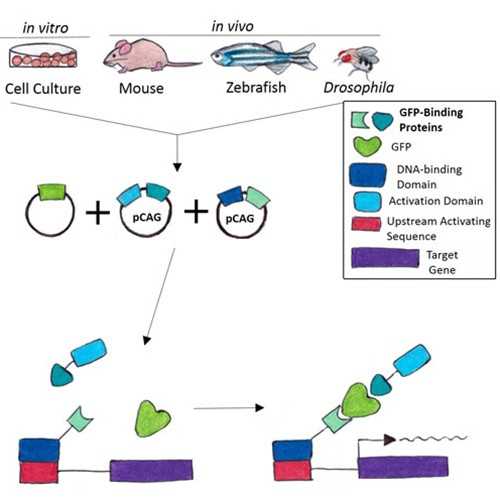pCAG-GBP1-10gly-Gal4DBD Plasmid
pCAG-Gal4DBD-10 gly-GBP1 is used along with pCAG-p65AD-GBP6 to activate UAS-regulated genes in cells expressing GFP. The vector allows the exchange of DNA-binding domain (DBD) or other proteins fused to the N-terminal end of GBP1 in the vector.
Green fluorescent protein (GFP) and its derivatives are commonly used markers of gene expression across model organisms. Notably, in the mouse, thousands of transgenic GFP lines have been generated; these reagents revealed the expression pattern of many genes and serve as reagents for labeling specific cell types. To extend the utility of transgenic GFP lines such that one can use GFP to directly manipulate any desired gene in the GFP-labeled cell types, we developed a synthetic system that uses GFP as a scaffold protein for inducing formation of a hybrid transcription factor. Recognition of GFP is mediated by GFP binding proteins (GBPs), which are single-chain GFP-binding domains derived from Camelid antibodies. Specific pairs of GBPs are capable of bringing together tethered DNA binding domain (DBD) and activation domain (AD) onto the GFP scaffold. Such a complex can then trigger induction of any gene regulated by an upstream activating sequence (UAS).
From the laboratory of Connie L. Cepko, PhD, Harvard University.
 Part of The Investigator's Annexe program.
Part of The Investigator's Annexe program.
pCAG-Gal4DBD-10 gly-GBP1 is used along with pCAG-p65AD-GBP6 to activate UAS-regulated genes in cells expressing GFP. The vector allows the exchange of DNA-binding domain (DBD) or other proteins fused to the N-terminal end of GBP1 in the vector.
Green fluorescent protein (GFP) and its derivatives are commonly used markers of gene expression across model organisms. Notably, in the mouse, thousands of transgenic GFP lines have been generated; these reagents revealed the expression pattern of many genes and serve as reagents for labeling specific cell types. To extend the utility of transgenic GFP lines such that one can use GFP to directly manipulate any desired gene in the GFP-labeled cell types, we developed a synthetic system that uses GFP as a scaffold protein for inducing formation of a hybrid transcription factor. Recognition of GFP is mediated by GFP binding proteins (GBPs), which are single-chain GFP-binding domains derived from Camelid antibodies. Specific pairs of GBPs are capable of bringing together tethered DNA binding domain (DBD) and activation domain (AD) onto the GFP scaffold. Such a complex can then trigger induction of any gene regulated by an upstream activating sequence (UAS).
From the laboratory of Connie L. Cepko, PhD, Harvard University.
 Part of The Investigator's Annexe program.
Part of The Investigator's Annexe program.
| Product Type: | Plasmid |
| Gene/insert name: | GBP1-Gal4 DNA binding domain (DBD) fusion protein; Contains the following mutations: C98S (to increase protein solubility), Q3D |
| Antibiotic Resistance: | Ampicillin |
| Format: | Liquid |
| Tested Applications: | Expression of a GFP-dependent transcription factor component in mammalian cells. For protocols, please see: Tang JC, et al. Cell. 2013 Aug 15;154(4):928-39. |
| Grow in E. coli at 37 C: | Yes |
| Cloning Site 5': | AgeI |
| Cloning Site 3': | NotI |
| 5' Sequencing Primer: | GGACTTCCTTTGTCCCAAATCTG |
| 3' Sequencing Primer: | TAGCCAGAAGTCAGATGCTC |
| Insert Size: | 843 bp |
| Vector Backbone and Size: | pCAG-GFP, 4823 |
| High or low copy: | High |
| Promoter: | CAG |
| Storage: | Lyophilized DNA is stable at room temperature indefinitely, reconstituted DNA to be stored in 4 degrees short-term, -20 degrees long term. |
| Shipped: | Ambient temperature |
Notes
pCAG-GBP1-10gly-Gal4DBD is a mammalian expression vector designed to express the DBD portion of a GFP-dependent transcription factor. Specifically, the Gal4 DBD is linked to the C-terminal end of GBP1 via a 10 glycine polylinker. Transcription of the fusion protein is driven by the early CMV enhancer/beta-actin promoter and terminated by a rabbit beta-globin polyadenylation signal. A Kozak consensus sequence (GCCACC) is placed directly in front of the start ATG for enhancing translation efficiency. A cysteine to serine mutation at residue 98 of fusion protein (within GBP1) was introduced to enhance solubility in cells. An ampicillin resistance gene in the plasmid allows for selection in E.coli. The SV40 ori sequence enables episomal replication of the plasmid in cells expressing the SV40 large-T antigen (e.g., 293T and COS-7 cells).
- Tang JC, Szikra T, Kozorovitskiy Y, Teixiera M, Sabatini BL, Roska B, Cepko CL. A nanobody-based system using fluorescent proteins as scaffolds for cell-specific gene manipulation. Cell. 2013 Aug 15;154(4):928-39.
If you publish research with this product, please let us know so we can cite your paper.


